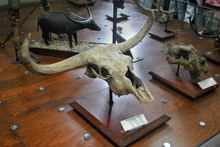| Bos palaesondaicus Temporal range: Pleistocene
| |
|---|---|

| |
| Bos palaesondaicus skull at the Bandung Geological Museum. | |

| |
| Partial skull at Naturalis. | |
| Scientific classification | |
| Domain: | Eukaryota |
| Kingdom: | Animalia |
| Phylum: | Chordata |
| Class: | Mammalia |
| Order: | Artiodactyla |
| Family: | Bovidae |
| Subfamily: | Bovinae |
| Genus: | Bos |
| Species: | †B. palaesondaicus
|
| Binomial name | |
| †Bos palaesondaicus (Dubois, 1908)
| |
| Synonyms | |
|
Bibos palaesondaicus Dubois, 1908 | |
Bos palaesondaicus occurred on Pleistocene Java (Indonesia) and belongs to the Bovinae subfamily. It has been described by the Dutch paleoanthropologist Eugène Dubois in 1908.[1] The holotype of Bos palaesondaicus is a skull from Trinil. This species is the likely ancestor to the banteng (Bos javanicus).[2][3]
References
[edit]- ^ Dubois, E. (1908). Das Geologische Alter der Kendengoder TrinilFauna. Tijdschr. Kon. Ned. Aardr. Gen., ser. 2, vol. 25, pp. 12351270, pl. 39.
- ^ Hooijer, D.A. (1958a). Fossil Bovidae from the Malay archipelago and the Punjab, Zoologische Verhandelingen van de Museum Leiden 38:1–112.
- ^ Hooijer, D. A. (1958b). Sexual differences in the skull of fossil and recent banteng. Mammalia 22:73–75.
Well, that’s interesting to know that Psilotum nudum are known as whisk ferns. Psilotum nudum is the commoner species of the two. While the P. flaccidum is a rare species and is found in the tropical islands. Both the species are usually epiphytic in habit and grow upon tree ferns. These species may also be terrestrial and grow in humus or in the crevices of the rocks.
View the detailed Guide of Psilotum nudum: Detailed Study Of Psilotum Nudum (Whisk Fern), Classification, Anatomy, Reproduction